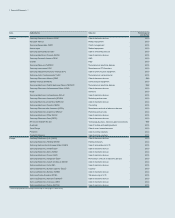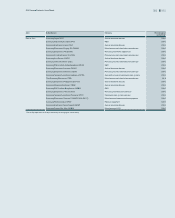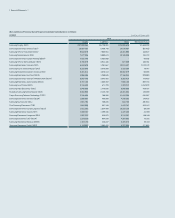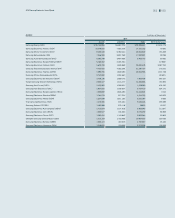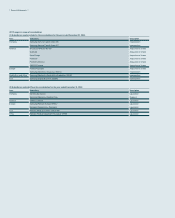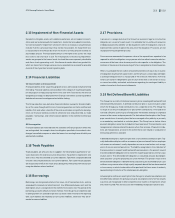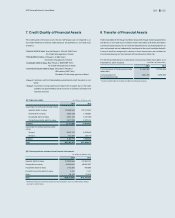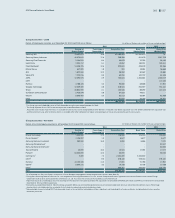Samsung 2014 Annual Report Download - page 59
Download and view the complete annual report
Please find page 59 of the 2014 Samsung annual report below. You can navigate through the pages in the report by either clicking on the pages listed below, or by using the keyword search tool below to find specific information within the annual report.
057056
2014 Samsung Electronics Annual Report2014 Samsung Electronics Annual Report
2.5 Cash and Cash Equivalents
Cash and cash equivalents include cash on hand, deposits held at call with banks,
and other short-term highly liquid investments that are readily convertible to a
known amount of cash and are subject to an insignificant risk of change in value.
2.6 Financial Assets
(A) Classification
The Group classifies its financial assets in the following categories: financial as-
sets at fair value through profit or loss, loans and receivables, available-for-sale
financial assets, and held-to-maturity financial assets. The classification depends
on the terms of the instruments and purpose for which the financial assets were
acquired. Management determines the classification of its financial assets at initial
recognition.
(1) Financial assets at fair value through profit or loss
Financial assets at fair value through profit or loss are financial assets held for
trading. A financial asset is classified in this category if acquired principally for the
purpose of selling in the short-term. Derivatives not subject to hedge accounting
and derivatives separated from financial instruments, such as embedded deriva-
tives, are also categorized as held for trading. Assets in this category are classified
as current assets.
(2) Loans and receivables
Loans and receivables are non-derivative financial assets with fixed or determin-
able payments that are not quoted in an active market. They are included in cur-
rent assets, except for those with maturities greater than 12 months after the end
of the reporting period which are classified as non-current assets.
(3) Available-for-sale financial assets
Available-for-sale financial assets are non-derivative financial assets that are either
designated in this category or not classified in any of the other categories. They
are included in non-current assets unless an investment matures or management
intends to dispose of it within 12 months of the end of the reporting period.
(B) Recognition and measurement
Regular purchases and sales of financial assets are recognized on the trade date.
At initial recognition, financial assets are measured at fair value plus, in the case
of financial assets not carried at fair value through profit or loss, transaction costs.
Transaction costs of financial assets carried at fair value through profit or loss are
expensed in the statement of income. After the initial recognition, available-for-
sale financial assets and financial assets at fair value through profit or loss are
subsequently carried at fair value. Loans and receivables and held-to-maturity in-
vestments are subsequently carried at amortized cost using the effective interest
method.
Changes in fair value of financial assets at fair value through profit or loss are
recognized in profit or loss and changes in fair value of available-for-sale financial
assets are recognized in other comprehensive income. When the available-for-
sale financial assets are sold or impaired, the fair value adjustments recorded in
equity are reclassified into profit or loss.
Interest on available-for-sale financial assets and held-to-maturity financial assets
calculated using the effective interest method is recognized in the statement of in-
come as part of financial income. Dividends on available-for-sale financial assets
are recognized in the statement of income as part of other non-operating income
when the Group’s right to receive payments is established.
(C) Offsetting financial instruments
Financial assets and liabilities are offset, and the net amount reported in the state-
ment of financial position, when there is a legally enforceable right to offset the
recognized amounts and there is an intention to settle on a net basis, or realize the
asset and settle the liability simultaneously.
(D) Derecognition of financial assets
If the Group transfers a financial asset and the transfer does not result in derecog-
nition because the Group has retained substantially all of the risks and rewards
of ownership of the transferred asset due to a recourse in the event the debtor
defaults, the Group continues to recognize the transferred asset in its entirety and
recognizes a financial liability for the consideration received. The related financial
liability is classified as ‘borrowings’ in the statement of financial position.
2.7 Impairment of Financial Assets
The Group assesses at the end of each reporting period whether there is objective
evidence that a financial asset or group of financial assets is impaired. A financial
asset or a group of financial assets is impaired and impairment loss is recognized
only if there is objective evidence and that loss event (or events) has an impact on
the estimated future cash flows of the financial asset or group of financial assets
that can be reliably estimated.
Impairment of loans and receivables is presented as a deduction in an allowance
account. Impairment of other financial assets is directly deducted from their carry-
ing amount. The Group writes off financial assets when the assets are determined
to no longer be recoverable.
The objective evidence that a financial asset is impaired includes significant
financial difficulty of the issuer or obligor, a delinquency in interest or principal pay-
ments, or the disappearance of an active market for that financial asset because
of financial difficulties. A decline in the fair value of an available-for-sale equity in-
strument by more than 20% from its cost or a prolonged decline below its cost for
more than six months is also objective evidence of impairment.



